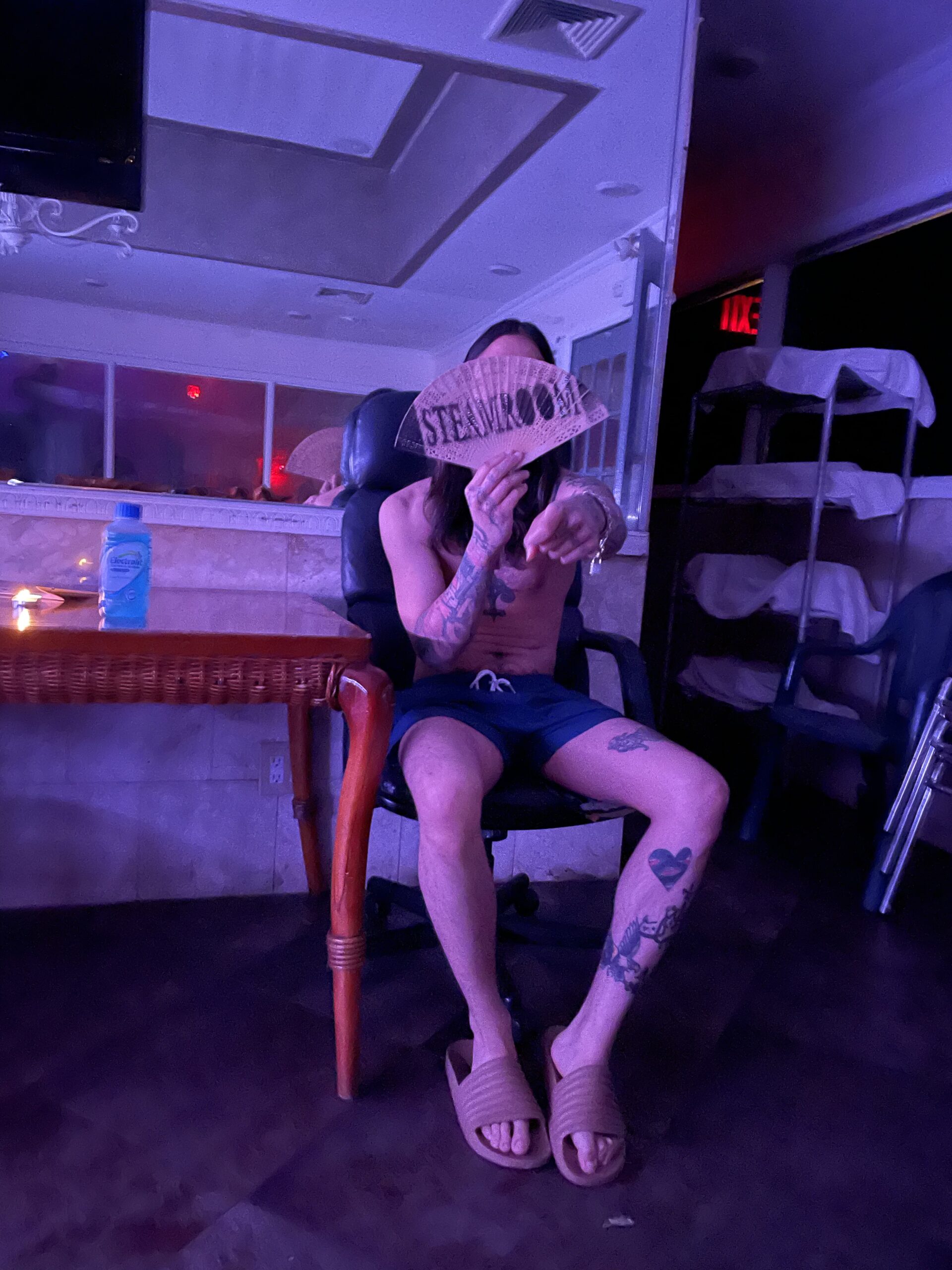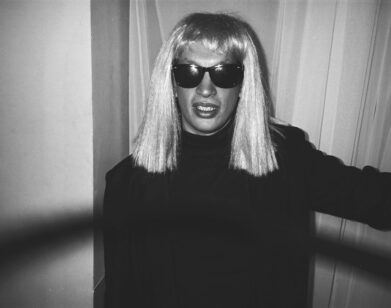SCHVITZ
Sam Liebling Is Bringing the Rave to the Bathhouse. Clothing Is Optional.
On a quiet industrial avenue in Flatbush, Brooklyn, a pack of twenty-somethings in layered sportswear huddle outside an auto body shop to smoke a cigarette before entering the local Russian bathhouse. What was once the go-to community headquarters for New Yorkers—where mafiosos, Rabbis, artists, cab drivers, and A-listers would congregate to schvitz under the same roof—is now the newest backdrop for the underground electronic music scene. The man behind it is Sam Liebling, founder of the techno party series Steamroom, which is building on the queer, sudsy history of bathhouses and reinvigorating the space with a modern, raving twist.
Bathhouse lore runs deep in New York City; it’s said that gangsters hired deaf masseurs so that their secrets would stay shrouded in the steam. Last weekend, at Steamroom, $20 (not including the price of admission) got you a key and a towel at Prospect South’s Brooklyn Banya, where patrons were met at the door by a pulsing beat and the musky smell of chlorine. Upstairs, the locker room buzzed with anticipation and curiosity. Should I take off my shoes? Are you finishing your drink? Can you hand me that towel? Bare breasts and penises bounced before settling into bathing suits. Ravers gave a quick lip-pout or booty-pop in the bathroom’s mirror, then scurried into the main room. What happens next, Liebling tells me with a wink, stays in the bathhouse. But before things got too rowdy, he and I snuck into a parlor room to talk naughty spa behavior, what makes a good rave, and how, by the grace of god, are they not fainting downstairs?
———
ALESSANDRA SCHADE: We are currently in a bathhouse in Brooklyn. I just stripped down in the locker room. I’m in a bikini. You’re in a bathing suit. Why are we here?
SAM LIEBLING: I mean, two years ago, when I was just tertiary in the electronic scene in New York, I was bored. I think that going out should be more interactive. Bathhouses and nightlife have always gone hand in hand and thinking of ways to try and make something more interactive just led to where we are.
SCHADE: There’s a history of bathhouse culture in New York. The lore goes that gangsters were doing business in saunas. Closeted folks could explore their sexuality in a safe, steamy environment. There were local bathhouses where rabbis and hippies were all schvitzing under the same roof. So, how is raving in a bathhouse in Brooklyn part of this lore?
LIEBLING: It all ties together in the sense that history repeats itself, but with variations. There is so much cultural significance between the queer scene and the bathhouse scene in New York, but I’m not even going to sit here and speak on it pretending that I am an expert. This party came out of learning more about the history and respecting my elders in a way, the people that came before and made this whole scene a thing.
SCHADE: At heart, bathhouses are very democratic. There’s no clothes, no classes, no divisions. What community is Sam’s bathhouse serving?
LIEBLING: A little bit of everyone. Despite the marketing or whatever people may think, this party has never been geared toward one demographic. It’s all about making raving and nightlife more experiential, something more than just being at a club or being in a warehouse. I asked myself, “What party would I want to go to?” and just created that. We wanted to create a space that’s just full-force freedom of expression.
SCHADE: My friends and boyfriend have been dying to know, have I come to an orgy? Is there naughty bathhouse behavior that happens in the steam?
LIEBLING: The answer is… you come and you find out.
SCHADE: So true. When did the idea of a techno rave in a bathhouse occur to you?
LIEBLING: It was super, super random. I was doing very low-level party promotion in Manhattan two, three years ago. And then I moved into Brooklyn and started to find my community within the electronic music scene until I moved what I was doing into Manhattan. The whole Steamroom thing was that I had overbooked myself for something and I was like, “What the fuck am I going to call this party?” I was like, “Steamroom.” And it had nothing to do with steam rooms. But lo and behold, it evolved and it got me thinking about what I can do with that name, because that party did really well.
SCHADE: What makes a good rave?
LIEBLING: I don’t fucking know.
SCHADE: You clearly do.
LIEBLING: I think that it’s very dependent on what people are looking to get out of the experience. Honestly, any rave can be a good rave. It’s details, production, and uniqueness, but the experience you get is very individual. So you come and you get what you get from it and leave the rest at the door.
SCHADE: You’ve built a pretty large community, a kind of if-you-know-you-know crowd. How have you cultivated a strong following while also keeping this insider, exclusive feel?
LIEBLING: I don’t want to give away the secret sauce. But we started to build with friends of friends and mutual connections, all of us being in the same techno, electronic scenes. We need people to come to our parties and people to be interested in what we’re doing, but I like the element of surprise. I don’t want everyone to know exactly what they’re getting themselves into, because then where’s the sport of the experience?
SCHADE: I feel like everyone downstairs had no idea what they were getting themselves into.
LIEBLING: None.
SCHADE: You’re building a fantasy. How does Steamroom compare to other techno events in the city?
LIEBLING: There’s a lot of labels in New York and there’s a lot of parties in New York. But I think the amalgamation of the two, building a platform and using it as a party to push local artists, is super important. We see that going on so much within the scenes we idolize in the EU and all over the world, and they all end up turning into something more than just a party. I never started this just to be like, “Oh, I’m throwing a rave in a bathhouse.” It has always been about one, creating an experience and two, furthering the electronic music scene in New York, because so many people have found community in it, including myself.
SCHADE: Speaking of, you dropped a record last week. Can you tell me about the music component of your project?
LIEBLING: We put out the first artist compilation on the 17th. It had been in the works for a few months but it all fell into place very quickly. There’s a couple artists on it that are not directly from New York. My friend Mika, who’s out in Berlin, put a track on it. My friend, Gautham, who goes by Decoder, put a track on it and he’s from Texas. But the rest of the artists are New York staples, basically. I wanted to do a project with a range of sounds, from ambient to psychedelic techno to trance. The goal is to revive the electronic music scene in New York. I’m not going to be the fucking one to do that, but I’m trying to.
SCHADE: My first thought when I heard about Steamroom is, “How are people not going to faint?” What safety precautions do you have?
LIEBLING: Of course we have EMTs on staff. And we are very much about safe usage. We try to keep it a little bit more tame than a normal warehouse rave, per se, because we’re in a bathhouse and it is hot. But we have EMTs on staff at all times. And the staff at the bathhouse is very well-trained in everything. They’ve been here for 30 years.
SCHADE: One last question. This an unconventional space, to say the least. Can you tell me any funny or memorable moments you’ve had in the five events you’ve had?
LIEBLING: I think my answer to that is… you just have to be at the party.










